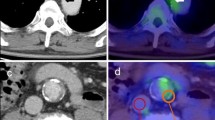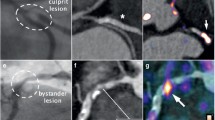Abstract
Purpose
It remains unclear whether changes in arterial wall inflammation are associated with subsequent changes in the rate of structural progression of atherosclerosis.
Methods
In this sub-study of the dal-PLAQUE clinical trial, multi-modal imaging was performed using 18-fludeoxyglucose (FDG) positron emission tomography (PET, at 0 and 6 months) and magnetic resonance imaging (MRI, at 0 and 24 months). The primary objective was to determine whether increasing FDG uptake at 6 months predicted atherosclerosis progression on MRI at 2 years. Arterial inflammation was measured by the carotid FDG target-to-background ratio (TBR), and atherosclerotic plaque progression was defined as the percentage change in carotid mean wall area (MWA) and mean wall thickness (MWT) on MRI between baseline and 24 months.
Results
A total of 42 participants were included in this sub-study. The mean age of the population was 62.5 years, and 12 (28.6 %) were women. In participants with (vs. without) any increase in arterial inflammation over 6 months, the long-term changes in both MWT (% change MWT: 17.49 % vs. 1.74 %, p = 0.038) and MWA (% change MWA: 25.50 % vs. 3.59 %, p = 0.027) were significantly greater. Results remained significant after adjusting for clinical and biochemical covariates. Individuals with no increase in arterial inflammation over 6 months had no significant structural progression of atherosclerosis over 24 months as measured by MWT (p = 0.616) or MWA (p = 0.373).
Conclusions
Short-term changes in arterial inflammation are associated with long-term structural atherosclerosis progression. These data support the concept that therapies that reduce arterial inflammation may attenuate or halt progression of atherosclerosis.



Similar content being viewed by others
References
Libby P, Ridker PM, Maseri A. Inflammation and atherosclerosis. Circulation. 2002;105:1135–43.
Inoue S, Egashira K, Ni W, Kitamoto S, Usui M, Otani K, et al. Anti-monocyte chemoattractant protein-1 gene therapy limits progression and destabilization of established atherosclerosis in apolipoprotein E-knockout mice. Circulation. 2002;106:2700–6.
Joseph P, Tawakol A. Imaging atherosclerosis with positron emission tomography. Eur Heart J. 2016. doi:10.1093/eurheartj/ehw147.
Tawakol A, Fayad ZA, Mogg R, Alon A, Klimas MT, Dansky H, et al. Intensification of statin therapy results in a rapid reduction in atherosclerotic inflammation: results of a multicenter fluorodeoxyglucose-positron emission tomography/computed tomography feasibility study. J Am Coll Cardiol. 2013;62:909–17.
Mizoguchi M, Tahara N, Tahara A, Nitta Y, Kodama N, Oba T, et al. Pioglitazone attenuates atherosclerotic plaque inflammation in patients with impaired glucose tolerance or diabetes a prospective, randomized, comparator-controlled study using serial FDG PET/CT imaging study of carotid artery and ascending aorta. J Am Coll Cardiol Img. 2011;4:1110–8.
Fayad ZA, Mani V, Woodward M, Kallend D, Abt M, Burgess T, et al. Safety and efficacy of dalcetrapib on atherosclerotic disease using novel non-invasive multimodality imaging (dal-PLAQUE): a randomised clinical trial. Lancet. 2011;378:1547–59.
Rudd JH, Myers KS, Bansilal S, Machac J, Rafique A, Farkouh M, et al. (18)Fluorodeoxyglucose positron emission tomography imaging of atherosclerotic plaque inflammation is highly reproducible: Implications for atherosclerosis therapy trials. J Am Coll Cardiol. 2007;50:892–6.
Mani V, Itskovich VV, Aguiar SH, Mizsei G, Aguinaldo JG, Samber DD, et al. Comparison of gated and non-gated fast multislice black-blood carotid imaging using rapid extended coverage and inflow/outflow saturation techniques. J Magn Reson Imaging. 2005;22:628–33.
Mani V, Woodward M, Samber D, Bucerius J, Tawakol A, Kallend D, et al. Predictors of change in carotid atherosclerotic plaque inflammation and burden as measured by 18-FDG-PET and MRI, respectively, in the dal-PLAQUE study. Int J Cardiovasc Imaging. 2014;30:571–82.
Taqueti VR, Di Carli MF, Jerosch-Herold M, Sukhova GK, Murthy VL, Folco EJ, et al. Increased microvascularization and vessel permeability associate with active inflammation in human atheromata. Circ Cardiovasc Imaging. 2014;7:920–9.
Abdelbaky A, Corsini E, Figueroa AL, Fontanez S, Subramanian S, Ferencik M, et al. Focal arterial inflammation precedes subsequent calcification in the same location: a longitudinal FDG-PET/CT study. Circ Cardiovasc Imaging. 2013;6:747–54.
Ridker PM, Buring JE, Cook NR, Rifai N. C-reactive protein, the metabolic syndrome, and risk of incident cardiovascular events: an 8-year follow-up of 14 719 initially healthy American women. Circulation. 2003;107:391–7.
Figueroa AL, Abdelbaky A, Truong QA, Corsini E, MacNabb MH, Lavender ZR, et al. Measurement of arterial activity on routine fdg pet/ct images improves prediction of risk of future CV events. J Am Coll Cardiol Img. 2013;6:1250–9.
Marnane M, Merwick A, Sheehan OC, Hannon N, Foran P, Grant T, et al. Carotid plaque inflammation on 18F-fluorodeoxyglucose positron emission tomography predicts early stroke recurrence. Ann Neurol. 2012;71:709–18.
LaRosa JC, Grundy SM, Waters DD, Shear C, Barter P, Fruchart JC, et al. Treating to New Targets I. Intensive lipid lowering with atorvastatin in patients with stable coronary disease. N Engl J Med. 2005;352:1425–35.
Cannon CP, Braunwald E, McCabe CH, Rader DJ, Rouleau JL, Belder R, et al. Pravastatin or Atorvastatin E, Infection Therapy-Thrombolysis in Myocardial Infarction I. Intensive versus moderate lipid lowering with statins after acute coronary syndromes. N Engl J Med. 2004;350:1495–504.
Schwartz GG, Olsson AG, Abt M, Ballantyne CM, Barter PJ, Brumm J, et al. Effects of dalcetrapib in patients with a recent acute coronary syndrome. N Engl J Med. 2012;367:2089–99.
Tawakol A, Singh P, Rudd JH, Soffer J, Cai G, Vucic E, et al. Effect of treatment for 12 weeks with rilapladib, a lipoprotein-associated phospholipase A2 inhibitor, on arterial inflammation as assessed with 18F-fluorodeoxyglucose-positron emission tomography imaging. J Am Coll Cardiol. 2014;63:86–8.
STABILITY Investigators. Darapladib for preventing ischemic events in stable coronary heart disease. N Engl J Med. 2014;370:1702–11.
O’Donoghue ML, Braunwald E, White HD, Lukas MA, Tarka E, Steg PG, et al. Effect of darapladib on major coronary events after an acute coronary syndrome: the SOLID-TIMI 52 randomized clinical trial. JAMA. 2014;312:1006–15.
Elkhawad M, Rudd JH, Sarov-Blat L, Cai G, Wells R, Davies LC, et al. Effects of p38 mitogen-activated protein kinase inhibition on vascular and systemic inflammation in patients with atherosclerosis. JACC Cardiovasc Imaging. 2012;5:911–22.
Emami H, Vucic E, Subramanian S, Abdelbaky A, Fayad ZA, Du S, et al. The effect of BMS-582949, a p38 mitogen-activated protein kinase (P38 MAPK) inhibitor on arterial inflammation: a multicenter FDG-PET trial. Atherosclerosis. 2015;240:490–6.
O’Donoghue ML, Glaser R, Cavender MA, Aylward PE, Bonaca MP, Budaj A, et al. Effect of losmapimod on cardiovascular outcomes in patients hospitalized with acute myocardial infarction: a randomized clinical trial. JAMA. 2016;315:1591–9.
Fihn SD, Gardin JM, Abrams J, Berra K, Blankenship JC, Dallas AP, et al. 2012 ACCF/AHA/ACP/AATS/PCNA/SCAI/STS guideline for the diagnosis and management of patients with stable ischemic heart disease: a report of the American College of Cardiology Foundation/American Heart Association task force on practice guidelines, and the American College of Physicians, American Association for Thoracic Surgery, Preventive Cardiovascular Nurses Association, Society for Cardiovascular Angiography and Interventions, and Society of Thoracic Surgeons. Circulation. 2012;126:e354-471.
Stone NJ, Robinson JG, Lichtenstein AH, Bairey Merz CN, Blum CB, Eckel RH, et al. 2013 ACC/AHA guideline on the treatment of blood cholesterol to reduce atherosclerotic cardiovascular risk in adults: a report of the American College of Cardiology/American Heart Association Task Force on Practice Guidelines. Circulation. 2014;129:S1–S45.
Ridker PM, Luscher TF. Anti-inflammatory therapies for cardiovascular disease. Eur Heart J. 2014;35:1782–91.
Facey K, Bradbury I, Laking G, Payne E. Overview of the clinical effectiveness of positron emission tomography imaging in selected cancers. Health Technol Assess. 2007;11:iii–iv. xi-267.
Hillner BE, Siegel BA, Hanna L, Duan F, Quinn B, Shields AF. 18F-fluoride PET used for treatment monitoring of systemic cancer therapy: results from the National Oncologic PET Registry. J Nucl Med. 2015;56:222–8.
Marcus C, Paidpally V, Antoniou A, Zaheer A, Wahl RL, Subramaniam RM. 18F-FDG-PET/CT and lung cancer: value of fourth and subsequent posttherapy follow-up scans for patient management. J Nucl Med. 2015;56:204–8.
Author information
Authors and Affiliations
Corresponding authors
Ethics declarations
Funding
This study was funded by F. Hoffmann-La Roche Ltd. Dr. Joseph is supported in part by a McMaster University Early Career Investigator award. Dr. Rudd is supported in part by the NIHR Cambridge Biomedical Research Centre, the British Heart Foundation and the Wellcome Trust.
Conflict of interest
P. Joseph, A. Ishai and V. Mani declare that they have no conflict of interest. D. Kallend was previously employed by and received share options from F. Hoffmann-La Roche Ltd. J. Rudd has received speaking honoraria from Roche. Z. Fayad has received research grants from Roche, GlaxoSmithKline, Merck, VBL Therapeutics, Novartis, Bristol-Myers Squibb and Via Pharmaceuticals, and speaking honoraria from Roche. A. Tawakol has received research grants from Merck, BMS, Takeda, Genentech, GlaxoSmithKline and VBL, and honoraria from Roche, BMS and Novartis.
Ethical approval
All procedures performed in studies involving human participants were in accordance with the ethical standards of the institutional and/or national research committee and with the 1964 Declaration of Helsinki and its later amendments or comparable ethical standards.
Informed consent
Informed consent was obtained from all individual participants included in the study.
Additional information
Philip Joseph and Amorina Ishai are co-primary authors.
Zahi A. Fayad and Ahmed Tawakol are co-senior authors.
Electronic supplementary material
Below is the link to the electronic supplementary material.
ESM 1
(DOCX 58 kb)
Rights and permissions
About this article
Cite this article
Joseph, P., Ishai, A., Mani, V. et al. Short-term changes in arterial inflammation predict long-term changes in atherosclerosis progression. Eur J Nucl Med Mol Imaging 44, 141–150 (2017). https://doi.org/10.1007/s00259-016-3524-0
Received:
Accepted:
Published:
Issue Date:
DOI: https://doi.org/10.1007/s00259-016-3524-0




